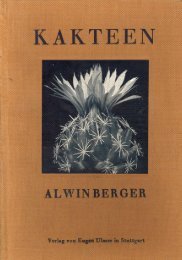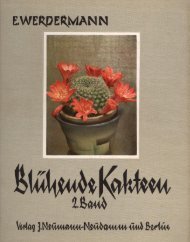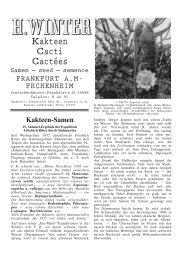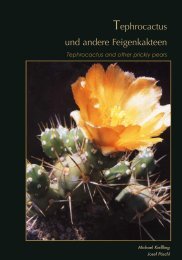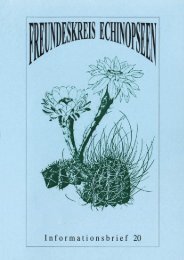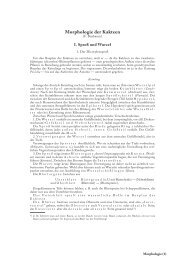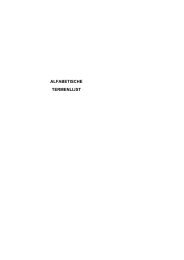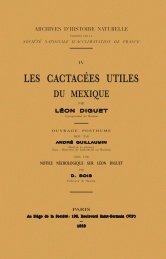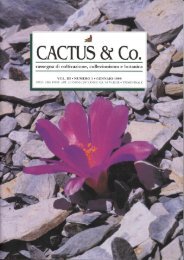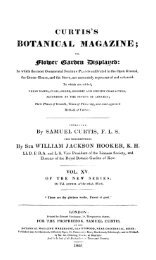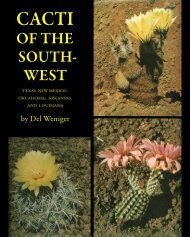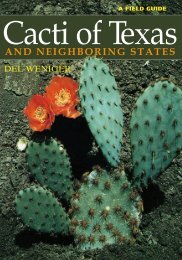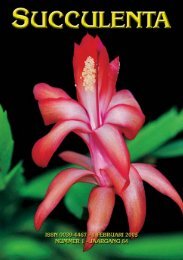the genus rebutia 1895—1981 - Free
the genus rebutia 1895—1981 - Free
the genus rebutia 1895—1981 - Free
Create successful ePaper yourself
Turn your PDF publications into a flip-book with our unique Google optimized e-Paper software.
aran… -><br />
arran…<br />
In proposing <strong>the</strong> following arrangement we realise that whatever scheme we<br />
propose it will not be universally accepted. We have not slavishly followed any one<br />
particular system but have attempted to amalgamate <strong>the</strong> best of a number of different<br />
arrangements. One of <strong>the</strong> criteria we have used is <strong>the</strong> breeding system, i.e. whe<strong>the</strong>r a<br />
species is self sterile or self fertile. This neatly divides <strong>the</strong> Section IV Rebutia into two<br />
workable subsections. It also divides <strong>the</strong> large Backeberg <strong>genus</strong> Mediolobivia into<br />
two distinct sections, Section II Mediolobivia and Section III Digito<strong>rebutia</strong>. There will<br />
always be a problem with those plants which bridge <strong>the</strong> gap between <strong>the</strong> different<br />
sections (being nei<strong>the</strong>r wholly self fertile, nor wholly self sterile), but we believe that<br />
ours is <strong>the</strong> most workable scheme to date.<br />
The following is an attempt at producing a description for <strong>the</strong> whole <strong>genus</strong> and is<br />
based on Buxbaum (1958).<br />
Rebutia K. Sch. emend Buining & Donald.<br />
Dwarf, globular or slightly cylindrical plants usually making offshoots from <strong>the</strong> base.<br />
Tubercles often distinct, spirally arranged and sometimes formed into distinct ribs.<br />
Spines very variable in length and colour; sometimes short, stiff and bristle-like but<br />
often long and flexuous. Flowers always produced from old areoles, usually<br />
appearing crowded at <strong>the</strong> base and very large in relation to <strong>the</strong> size of <strong>the</strong> plant. The<br />
flowers are brilliantly coloured, red, yellow, purple and occasionally white,<br />
campanulate or funnel-shaped. The receptacular scales are sometimes naked but in<br />
o<strong>the</strong>rs with copious hairs and bristles. Stamens are produced from <strong>the</strong> funnel part of<br />
<strong>the</strong> flower never from a ring in <strong>the</strong> throat. Occasionally <strong>the</strong> style is united to <strong>the</strong><br />
receptacle wall. The fruit is a small capsule which opens by a circular split so that <strong>the</strong><br />
lower half which remains on <strong>the</strong> plant is like a shallow bowl in which some of <strong>the</strong><br />
seeds remain. Seeds small, black and shining but also dull and earth coloured in<br />
some species.<br />
Classification of <strong>the</strong> <strong>genus</strong> Rebutia<br />
Rebutia K. Sch. emend. Buining & Donald Type species Rebutia minuscula K. Sch.<br />
Section I Aylostera (type Rebutia deminuta (Web.) Br. & R.)<br />
Section II Mediolobivia (type Rebutia aureiflora Backbg.)<br />
Subsection I Seti<strong>rebutia</strong>e<br />
Subsection II Cylindro<strong>rebutia</strong>e<br />
Section III Digito<strong>rebutia</strong> (type Rebutia pygmaea (R. E. Fries) Br. & R.)<br />
Subsection I Pygmaeae<br />
Subsection II Euan<strong>the</strong>mae<br />
Section IV Rebutia (type Rebutia minuscula K. Sch.)<br />
Subsection I Rebutiae<br />
Subsection II Medio<strong>rebutia</strong>e<br />
Lists of <strong>the</strong> species which belong to a particular Section or Subsection, toge<strong>the</strong>r with<br />
distribution maps and locational data, are given in <strong>the</strong> chapter devoted to<br />
geographical distribution.<br />
6



